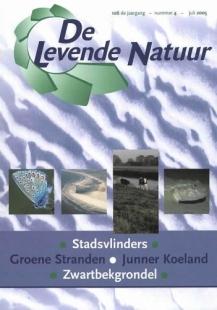De Levende Natuur nummer 4 van 2005 (English summary)
Afbeelding

Urban butterflies profit from ecological management
Swaay, C.A.M. & A.J. van Strien
Since 1990 the ecological management of urban areas has become increasingly popular. We studied the effects of management by comparing sites that were managed on a traditional way with sites that were managed ecologically. Densities and trends of sixteen common butterfly species were derived from the Dutch Butterfly Monitoring Scheme. The number of butterfly species did not differ between management type. The densities or trends of four butterflies, among which Maniola jurtina,were higher on ecologically managed sites and two species had a higher density or trend on traditionally managed sites. For three species the density on traditional managed sites was higher, but the trend here was more negative. This means that in the near future the number of butterflies of these species on ecologically managed sites will rise. Ecologically managed urban areas offer new opportunities for butterflies, especially for grassland species. These urban areas may become even more important for butterflies now butterflies decrease so rapidly in agricultural areas.
A new green beach on Schiermonnikoog
Bakker, J.P., R.M. Veeneklaas, A. Jansen & A. Samwel
The Wadden Sea island of Schiermonnikoog featured a small green beach in the 1960s. It became separated from the beach by an artificial sand dike and transformed into a species-rich dune slack. In the 1990s a sand bank became attached to the island. This provided enough sand supply to build a ridge of low primary dunes at the north-exposed beach. Such a ridge did not establish at the west-exposed beach. Nevertheless, vegetation started to emerge at the entire beach amounting to a zone of 200 – 400 m width and over 10 km long. Along the entire green beach salt-marsh species are found. However, dune slack species do not occur all along the beach in the shelter of the primary dune ridge. They are restricted to the beach where low soil salinity levels are found as a result of fresh seepage water from the massive dunes at the center of the island. When only a narrow dune ridge is found adjacent to the beach, the salinity is higher, and dune slack species are lacking.
Vegetation development on a green beach on Ameland
Tooren, B.F.van & J. Krol
At the north-west coast of the island of Ameland a new sand ridge has been formed during the last 10 years, ca 1 kilometer outside the beach. Between the old and the new beach a tidal flat developed (pictures 1 and 2). On a part of the old beach a rapid development of vegetation was observed, forming a so called 'green beach'. Important invading species were Glaux maritima, Salicornia europaea, Puccinellia maritima and P. distans. On small dunes Elytrigia juncea was growing. In a few years a rather dense vegetation was formed. Phragmites australis is one of the most important species now, species of calcareous dune slacks are still very scarce. The future development of the vegetation is discussed.
Green beaches on Rottumerplaat
Kers, A.S. & H. Koppejan
Due to erosion of the Westerduinen on the Wadden Sea island of Rottumerplaat a sand bank has developed on the northwestern side of the island. In the shelter of this bank a new green beach is still growing, while in the southwest green beaches in the shelter of the Westerduinen are threatened by erosion. To held these unique systems and processes, it is necessary that nature can do what it wants, without interference by man.
River-valley flora along the Overijsselse Vecht: how long will it last?
Ruiter, H.W.
The characteristic river valley flora of the Overijsselse Vecht is severely endangerd. Many Red-List species have declined or have disappeared during the last decades. These groundwater independent species are characteristic of weakly-buffered and nutrient-poor grasslands, the so called 'koelanden', which have been grazed by cattle from the Middle Ages. Compared to the period 1915-1938, the intensity of grazing has been reduced by 80%. Moreover, the deposition of fresh, calcium-containing sands has reduced due to canalization of the river Vecht at the end of the 19th century. These changes in combination with airborne nitrogen and acid deposition led to accumulation of organic material, acidification of the topsoil and an increased supply of nutrients, due to which the original low-productive vegetation has become ruderalized and felted. To counteract this deterioration, recovery of the former river dynamics of the Vecht is required to restore the deposition of fresh, calcium-containing sands. Societally, this is only possible on the long term. On the short term, acidification and eutrophication should be counteracted by a combination of (1) topsoil removal, (2) adding of limestone and (3) intensification of cattle grazing during late summer and autumn.
Round goby: a new fish species in The Netherlands
Beek, G.C.W. van
In December 2004 two new fish specimens were caught in the river Lek near Schoonhoven (The Netherlands). Determination based on Berg (1949) and Miller (2003) showed that the fishes belonged to Neogobius melanostomus Pallas (1811). After this first observation, several hundred individuals have been caught on different locations in the western part of the country. As is the case in the Great Lakes (U.S.) and Baltic Sea, the species could also become an invasive species for The Netherlands. As a result of the possible invasion, the ecosystem might change and native fish species could become (locally) endangered. Therefore, the species should be monitored closely to determine its present distribution area as well as their impact on the local ecosystem.

